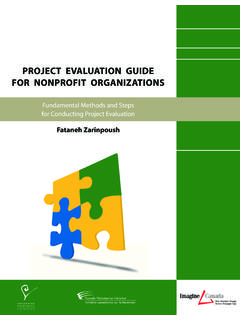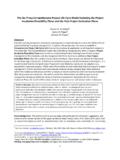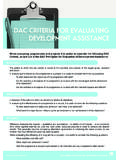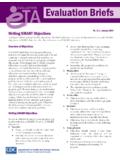Transcription of Guidelines for Project and Programme Evaluations - OECD
1 FINAL DRAFT July 2009 Guidelines for Project and Programme Evaluations Imprint: Austrian Development Agency The Operational Unit of the Austrian Development Cooperation Zelinkagasse 2, 1010 Vienna, Austria Phone: +43 (0)1 90399-0 Fax: +43 (0)1 90399-1290 These Guidelines were written by: Austrian Development Agency, evaluation Unit Vienna, October 2008 English Translation, Vienna, July 2009 Project AND Programme Evaluations Content 1. Introduction 1 2. Purpose of reviews 3 3. Purpose of Project and Programme Evaluations 4 4. International evaluation principles and standards 5 5. The management of Project and Programme Evaluations by Project partners (internal evaluation ) 6 6. The management of Project and Programme Evaluations by coordination offices or headquarters of the Austrian Development Agency (external evaluation ) 8 7.
2 Annexes 9 Definitions 10 OECD/DAC evaluation criteria 12 OECD/DAC evaluation criteria for humanitarian aid 18 Format for Terms of Reference 23 Cross-cutting issues (poverty, gender, environment) 25 Coordination details of an evaluation 26 International evaluation quality standards (DAC evaluation Standards) 31 Gender checklist 36 Format for an inception report 37 Format for a data collection planning worksheet 38 Format for an evaluation report 39 Format for a management response 41 Challenges for an evaluation or the evaluation team 42 Further literature and internet addresses 43 Project AND Programme Evaluations Guidelines | 1 evaluation : The systematic and objective assessment of an on-going or completed Project or Programme , its design, implementation and results.
3 The aim is to determine the relevance and fulfillment of objectives, development efficiency, effectiveness, impact and sustainability. (OECD DAC Glossary). Monitoring: A continuing function that uses systematic collection of data on specified indicators to provide management and the main stakeholders of an ongoing development intervention with indications of the extent of progress and achievement of objectives and progress in the use of allocated funds. (OECD DAC Glossary). Review: An assessment of the performance of an intervention, periodically or on an ad hoc basis. Reviews are usually less comprehensive and/or in-depth than Evaluations . They tend to emphasize operational aspects. (OECD DAC Glossary). 1. Introduction The Guidelines are intended to support Project partners which implement projects or programmes supported by the Austrian Development Cooperation (ADC) during the process of planning, commissioning and managing Project and Programme Evaluations .
4 Furthermore, it addresses also those officers of the Austrian Development Agency (ADA) and the Coordination Offices (COs) that are in charge of contracting and coordinating Project or Programme evaluations1. The Guidelines delineate the administrative processes, which need to be applied if the costs of Project -/ Programme Evaluations are included in the approved budget, or if Project or Programme Evaluations are commissioned by ADA headquarters officers or COs. ADA uses the internationally approved definitions for Monitoring, evaluation and Review, which correspond to the OECD/DAC Glossary2: Evaluations are generally conducted by independent, external experts. In general, an evaluation analyses complex issues and captures intended and unintended effects.
5 Evaluations investigate the reasons why certain aspects of a Project or Programme have or have not been implemented as planned. Evaluations are carried out either during the Project cycle (Mid-term evaluation , Formative evaluation ) or at the end of a Project or Programme (Ex-post evaluation , Final evaluation , Impact evaluation , Summative evaluation )3. 1 This document is not applicable for Evaluations directly commissioned by the ADA evaluation Unit (particularly strategic Evaluations ) or projects or programmes based on a direct agreement of ADA with a foreign state or a foreign public institution (National Execution). Likewise, it is not to be applied for Impact Assessments or Impact Evaluations .
6 2 See also Annex 3 Definitions are illustrated in the Annex. Project AND Programme Evaluations 2 | Guidelines Evaluations have the following characteristics: the five OECD/DAC evaluation criteria of Relevance, Effectiveness, Efficiency, Impact and Sustainability are covered, cross-cutting issues, such as poverty, gender and environment, are taken into consideration4, and the intervention logic ( Logframe) is analysed. Additional criteria may also be added such as Participation or Responsibility . The five OECD/DAC criteria are defined as follows: Relevance Are we doing the right thing? How important is the relevance or significance of the intervention regarding local and national requirements and priorities? Effectivenes Are the objectives of the development interventions being achieved?
7 How big is the effectiveness or impact of the Project compared to the objectives planned (Comparison: result planning)? Efficiency Are the objectives being achieved economically by the development intervention? How big is the efficiency or utilisation ratio of the resources used (Comparison: resources applied results)? Impact Does the development intervention contribute to reaching higher level development objectives (preferably, overall objective)? What is the impact or effect of the intervention in proportion to the overall situation of the target group or those effected? Sustainability Are the positive effects or impacts sustainable? How is the sustainability or permanence of the intervention and its effects to be assessed5? In Annex and , these five criteria are illustrated in more detail.
8 If it is not possible to consider all five OECD/DAC criteria, this needs to be justified in the Terms of Reference (ToR). In all Evaluations , the evaluation questions must be formulated in accordance with the OECD/DAC evaluation criteria of Relevance, Effectiveness, Efficiency, Impact and Sustainability. ADA follows the international trend and defines those Evaluations that are managed by the Project partners themselves as "internal Evaluations " (even if external experts are engaged). Those Evaluations that are managed by ADA (Headquarters, Coordination Offices) are considered as "external Evaluations ", as they are not subordinate to the direct Project management. 4 Further details are to be obtained from the Annex.
9 5 Further clarifications are to be obtained from the Annex. Project AND Programme Evaluations Guidelines | 3 Consequently, ADA distinguishes between three types of Evaluations : As far as the budget is concerned external Evaluations of Type I are assigned to the ADA evaluation Unit. External Evaluations of Type II are assigned to the budget line, from which the respective Project is financed. The costs for internal Evaluations need to be considered in the Project or Programme budget. Every Project or Programme must be evaluated once internally within the Project or Programme cycle. Additionally, projects or programmes can also be evaluated externally. In a particular case and in the event of an external evaluation being planned, an internal evaluation can be abstained from.
10 In any case, the costs of an evaluation must be in an appropriate proportion to the scope of the Project . Consequently, an evaluation is rather unlikely in case of small projects (see also Chapter 5.). In general terms, approximately 3 5 % of the entire Project or Programme budget is provided for an evaluation . 2. Purpose of reviews In comparison with Project and Programme Evaluations , reviews are less complex analyses. Neither do they necessarily contain an analysis according to the five OECD/DAC criteria nor must they be responsive to cross-cutting issues. However, it is also recommended to analyse the intervention logic ( Logframe) in each review. Reviews are appropriate if the Project or the Programme is analysed, in order to, interpret already existing results, work out lessons learnt together, or develop future strategies, which result from lessons learnt.













![[PROJECT PROPOSAL EVALUATION MANUAL] - HRZZ](/cache/preview/b/0/7/1/8/4/3/7/thumb-b0718437529be1869860af30917bb930.jpg)




